If you need a root canal in California, get ready to spend between $700 and $1,500 per tooth. Several other reasons support this variation, including the tooth’s location in your mouth, the difficulty of the treatment, and the dentist’s experience. The operational cost in cities such as Los Angeles raises the price for such services, and demand for specialized dental services is also relatively high.
If you need a root canal, you may wonder about the shocking price differences. For example, a simple root canal of a front tooth might be priced as low as $700, while more complicated ones on molars could reach up to $1,500. Discussing these matters with your dentist during your initial consultation would be best so you are not dumbfounded later.
Key Highlights
- Cost Range: Root canal costs in California (cost of root canal ca dentist) typically fall between $700 and $1,500 per tooth.
- Molars: Expect to pay more for molars, as they often require more extensive work due to multiple canals.
- Insurance Impact: Depending on your plan, insurance can significantly reduce costs.
What is a Root Canal Treatment?
A root canal is an intensive treatment that saves an infected or badly decayed tooth. Your dentist will eliminate the infected or destroyed pulp inside your tooth. The pulp is a center of blood vessels and nerves; when damaged, pain and sensitivity might become unbearable. According to endodontics, root canal, and crown treatment are essential for decayed teeth.
The Root canal procedure Involves:
- Diagnosis: The dentist or endodontist will first diagnose the extent of the damage using X-rays and other diagnostic tools.
- Schedule an appointment: You will book an appointment with the dental office.
- Anesthesia: Local anesthesia is administered to numb the area, ensuring a pain-free experience.
- Accessing the Pulp: A small opening is made in the tooth to access the infected or damaged pulp.
- Removing the Pulp: The infected or damaged pulp is carefully removed, and the canals inside the tooth are cleaned and disinfected.
- Filling the Canals: The cleaned canals are filled with a biocompatible material, typically gutta-percha, to seal them and prevent future infection.
- Restoration: The tooth is then restored with a dental crown or filling to protect it and restore its function.
- Dental care: After treatment, it is essential to visit the dentist to maintain proper oral health.
Why is Root Canal Treatment Necessary?
It is treatment when the pulp becomes infected and inflamed in a tooth. This could be due to numerous factors:
- Deep Decay: When cavities penetrate the tooth, the bacteria may reach the pulp, causing infection.
- Trauma: A chip or fracture in your tooth allows bacteria to penetrate the pulp, resulting in an infection.
- Multiple procedures Repeated dental procedures on a tooth can irritate the pulp and cause the pulp to become inflamed.
- Severe Gum Diseases: Advanced gum diseases can cause infection to the root of the tooth.
If not treated early, the infection progresses to an abscess, which is associated with severe pain and tooth loss. A root canal relieves the pain and saves the tooth from extraction, preserving your natural smile.
How much does a root canal cost in California (CA)?
The price of a root canal may vary and depend on the type of tooth being treated. The average cost of root canal ca dentist is around $1100 to $1600, whereas insurance costs will differ according to your dental insurance plan. Since every type presents its challenges, this affects the cost.
Front Tooth Root Canal Cost
Incisors and canines usually feature only one canal. In this way, the root canal treatment of such anterior teeth usually turns out to be less complicated and, thus, cheaper.
You are probably looking at $700 to $1,100 for a root canal on an anterior tooth. Since access is more manageable in these teeth, all the time and work of the whole procedure are much less.
Premolar Root Canal Cost
The premolars are between the front teeth and molars and have one or two canals. Given that there is possibly more than one canal, such teeth are relatively more complex and costlier for root canal treatment.
Treatment costs for a root canal on a premolar can range from about $800 to $1,200. Due to their role in food chewing, premolars are considered essential teeth to conserve through good dental hygiene.
Molar Root Canal Cost
They are usually situated towards the back of your mouth and generally feature three or four canals. Due to positioning and the number of canals involved, root canals on the molars are inclined to be the most complicated to perform.
In cases of molars, root canal therapies are costlier and fall between $1,000 and $1,500. Since the molar bears more chewing force, keeping the tooth intact and healthy is essential.
Root Canal Treatment (rct) Cost in Major California Cities
Another factor that may affect root canal treatment costs is depending on the location. For instance, a dentist in the metropolis may face a higher cost of living and, at times, greater demand for special services.
This may cost approximately $1,000 to $1,500 in Los Angeles. It can then be associated with the city’s overall high cost of living and the population’s demand for skilled dental services.
In San Francisco, one of the costliest cities in terms of living, a root canal could cost $1,100 to $1,600. In San Diego, prices of root canals range in at $950 to $1,400.
The most affordable of the large cities is Sacramento, which provides low-cost root canal treatment ranging from $900 to $1,350.
These variations suggest that trying to estimate the cost of a root canal will depend mainly on where you are. While staying in a generally high-priced place, you may find that traveling to another city nearby could save you quite a reasonable sum of money.
| City | Average cost |
| Los Angeles | $1000-$1500 |
| San Francisco | $1100-$1600 |
| San Diego | $950-$1300 |
| Sacramento | $900-$1350 |
Cost of Root Canal with & Without Insurance
Dental insurance can cut down on many costs for a root canal. Most plans undergird root canals by covering 50% to 80% of the total fee, depending on the plan’s deductible, co-pay, and annual maximum. An insurance plan that underlines 70% out-of-pocket expenses would be $360 for a $1,200 root canal.
However, you must read your insurance document carefully to ascertain whether it provides coverage for the root canals. For example, some policies pay only an allowance for the procedure, thus making you pay the balance.
Moreover, if a dentist is not in the network, the insurance will pay a smaller percentage of the bill, allowing you to make larger payments.
| Tooth Type | Without insurance | With 50% insurance | With 80% insurance |
| Front | $1000 | $500 | $200 |
| Premolar | $1200 | $600 | $240 |
| Molar | $1500 | $750 | $300 |
Note: These estimates assume the insurance plan covers the procedure at the specified percentages. Always check with your insurance provider for specific coverage details.
Factors That Affect Root Canal Treatment (rct) Cost
Everything determines the cost of your root canal. Knowing what determines these costs will help you anticipate the bottom line and make informed decisions about your dental care.
- Type of Tooth: The type treated, whether a front tooth, premolar, or molar, strongly influences the cost. Molars have several canals and often difficult access; hence, they usually tend to be more expensive when being treated compared to the front teeth.
- Dentist experience: The more experienced or specially trained the dentist, the higher the charges will likely be. However, their expertise often means that the treatment is usually more successful and faster, which may save money in the long run by avoiding complications or additional procedures.
- Geographical location: Lastly, the expenses of living in your area should be considered. Major urban centers like Los Angeles or San Francisco are generally more expensive than small towns or rural areas because dentists in such major cities operate on higher costs, which they pass down to their patients.
- How complicated the procedure will be: The moment you find out that some of your teeth have narrow or curved canals, or other factors that might complicate the procedure, you should be prepared to pay more. Complicated cases take more time and expertise; such methods are costly.
- Insurance Coverage: Your out-of-pocket cost will vary depending on your insurance plan. Some plans may cover a higher percentage of the price if you use an in-network dentist.
Insurance Coverage and Payment Plans for Root Canal
Does Dental Insurance Cover Root Canal Treatment?
Most dental insurance covers root canal treatment, but that varies with the plan. Usually, it is 50%, up to 80%, and contingent upon the person’s specific insurance and whether or not the dentist is in or out of the network. Some of these plans can be accompanied by waiting periods or capped out with annual maximums, thus affecting coverage.
Key Thoughts:
- In-network versus out-of-network: Finding an in-network dentist may lower your out-of-pocket expenses because dental plans usually cover more when you go to an in-network provider.
- Annual Maximums: Most dental insurances are packaged with an annual maximum, which is the maximum amount it will pay in any given year. You will be responsible for the balance if your root canal bill exceeds that amount.
Payment Plans and Financing Options for Root Canal Treatment
Most dental offices offer options such as financing and even payment plans for people with no insurance or, if you need assistance in picking up the remaining balance, for them to enable you to pay over time for the procedure.
Common Fundraising Alternatives:
- CareCredit: A health care credit card for treatments and procedures not covered by insurance, which also offers flexible payment options.
- In-house payment plans: Most dental offices also provide financing, which means you can get the procedure and pay for it through installments. Personal Loans: A loan for personal needs can be taken to afford the procedure; however, one must be cautious because it entails an interest rate.
Ways to Get Affordable Root Canal Treatment
The root canal cost varies by your dental insurance coverage and your location. Root canal costs with insurance will be different from paying it out of your pocket. If your average root canal costs $1000, you may get low cost by these methods:
Dental Discount Plans
Dental discount plans are not considered traditional insurance. In exchange for an annual fee, dental discount plans provide certain services, like root canals, at a negotiated discounted rate. Depending on the provider and the specific plan, this could reduce the cost of a root canal by 10% to 60% or more.
- Dental Discount Plans: The Pros
No Waiting Period: Most dental discount plans do not have waiting periods, as some of the more traditional insurance plans did, to allow you to seek immediate treatment. - No Maximums: Dental discount plans have no maximums, so you can use them for dental treatments as many times as you like, whether you are getting endodontic treatment or dental implants.
Dental Schools and Low-Cost Clinics
Also, most dental schools offer dental services to patients being observed at low fees. Most of these procedures are heavily discounted because they are part of the student’s curriculum. Other community clinics base their services on a person’s low income level, so they are super affordable for those who have no insurance.
- Supervised care: All procedures carried out by students are performed under close, appropriate supervision by highly qualified instructors.
- Accessibility: Appointments in dental school and low-cost clinics are usually limited, often leading to longer wait times.
In-Network vs. Out-of-Network Dentists
Hence, choosing a contracted dentist will cover most of the expense since the insurance plans cover more of the expense once the in-network provider sees the patient. If an out-of-network dentist was chosen, the out-of-pocket expenses would increase, with the insurance then covering a lesser percentage or none at all.
In-Network Dentists: How To Find
- Insurance website: Most insurance providers have a website directory relating to in-network dentists, which is comparatively easy to access regarding area providers.
- Ask your dentist: You can ask your favorite dentist whether he/she is part of the insurance network you are in.
Conclusion
The cost of root canals in California varies widely based on factors such as the tooth’s category, the complexity of the procedure, the dentist’s expertise, and the location of the practice. This article explains how these factors work and goes on to explain options such as insurance plans, payment options, and discount plans, which could enable one to estimate the cost.
You will need to verify all of this with your dentist and insurance company to get the most accurate estimate of your out-of-pocket expense. These options include checking into dental schools, low-cost clinics, and in-network providers to lower the overall cost of the treatment.
FAQs
- How painful is a root canal procedure?
The procedure usually causes minimal pain, as dentists use local anesthesia to numb the area. Most patients experience only mild discomfort during and after the procedure.
- How long does a root canal take?
A typical root canal takes about 60 to 90 minutes, depending on the complexity of the tooth. Molars with more canals might take longer to treat than front teeth.
- Can I avoid a root canal?
In some cases, if the infection is caught early, you might avoid a root canal with less invasive treatments like fillings. However, once the pulp becomes infected, a root canal or extraction is often necessary to save the tooth.
- What happens if I don’t get a root canal?
If you delay or avoid getting a root canal, the infection can spread, leading to more severe pain, tooth loss, and even systemic health issues.
- How long does a root canal-treated tooth last?
A tooth treated with a root canal can last a lifetime with proper care. However, good oral hygiene and regular dental check-ups are essential.





